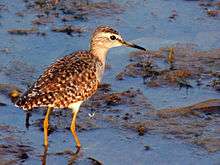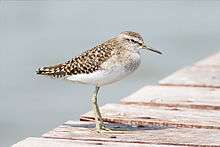Wood sandpiper
| Wood sandpiper | |
|---|---|
 | |
| Wood sandpiper Mangaon, Maharashtra, India | |
| Scientific classification | |
| Kingdom: | Animalia |
| Phylum: | Chordata |
| Class: | Aves |
| Subclass: | Neornithes |
| Order: | Charadriiformes |
| Family: | Scolopacidae |
| Genus: | Tringa |
| Species: | T. glareola |
| Binomial name | |
| Tringa glareola (Linnaeus, 1758) | |
| Synonyms | |
The wood sandpiper (Tringa glareola) is a small wader. This Eurasian species is the smallest of the shanks, which are mid-sized long-legged waders of the family Scolopacidae. The genus name Tringa is the New Latin name given to the green sandpiper by Aldrovandus in 1599 based on Ancient Greek trungas, a thrush-sized, white-rumped, tail-bobbing wading bird mentioned by Aristotle. The specific glareola is from Latin glarea, " gravel".[2]
Description and systematics
It resembles a longer-legged and more delicate green (T. ochropus) or solitary sandpiper (T. solitaria) with a short fine bill, brown back and longer yellowish legs. It differs from the first of those species in a smaller and less contrasting white rump patch, while the solitary sandpiper has no white rump patch at all.[3]
However, it is not very closely related to these two species. Rather, its closest relative is the common redshank (T. totanus), and these two share a sister relationship with the marsh sandpiper (T. stagnatilis). These three species are a group of smallish shanks with red or yellowish legs, a breeding plumage that is generally subdued light brown above with some darker mottling and with a pattern of somewhat diffuse small brownish spots on the breast and neck.[3][4]
Ecology

The wood sandpiper breeds in subarctic wetlands from the Scottish Highlands across Europe and Asia. They migrate to Africa, Southern Asia, particularly India, and Australia. Vagrant birds have been seen as far into the Pacific as the Hawaiian Islands. In Micronesia it is a regular visitor to the Mariana Islands (where flocks of up to 32 birds are reported) and Palau; it is recorded on Kwajalein in the Marshall Islands about once per decade. This species is encountered in the western Pacific region between mid-October and mid-May.[3][5][6][7] A slight westward expansion saw the establishment of a small but permanent breeding population in Scotland since the 1950s.
This bird is usually found on freshwater during migration and wintering. They forage by probing in shallow water or on wet mud, and mainly eat insects and similar small prey. T. glareola nests on the ground or uses an abandoned old tree nest of another bird, such as the fieldfare (Turdus pilaris).[3] Four pale green eggs are laid between March and May.
The wood sandpiper is one of the species to which the Agreement on the Conservation of African-Eurasian Migratory Waterbirds (AEWA) applies.
Widespread, it is considered a Species of Least Concern by the IUCN.[8]
References
- ↑ BirdLife International (2012). "Tringa glareola". IUCN Red List of Threatened Species. Version 2013.2. International Union for Conservation of Nature. Retrieved 26 November 2013.
- ↑ Jobling, James A (2010). The Helm Dictionary of Scientific Bird Names. London: Christopher Helm. pp. 174, 390. ISBN 978-1-4081-2501-4.
- 1 2 3 4 Hayman, Peter; Marchant, John; Prater, Tony (1986). Shorebirds: an identification guide to the waders of the world. Boston: Houghton Mifflin. ISBN 0-395-60237-8.
- ↑ Pereira, S.L.; Baker, A.J. (2005). "Multiple Gene Evidence for Parallel Evolution and Retention of Ancestral Morphological States in the Shanks (Charadriiformes: Scolopacidae)". Condor. 107 (3): 514–526. doi:10.1650/0010-5422(2005)107[0514:MGEFPE]2.0.CO;2.
- ↑ Wiles, Gary J.; Worthington, David J.; Beck, Robert E. Jr.; Pratt, H. Douglas; Aguon, Celestino F.; Pyle, Robert L. (2000). "Noteworthy Bird Records for Micronesia, with a Summary of Raptor Sightings in the Mariana Islands, 1988–1999" (PDF). Micronesica. 32 (2): 257–284.
- ↑ VanderWerf, Eric A. (2006). "Observations on the birds of Kwajalein Atoll, including six new species records for the Marshall Islands" (PDF). Micronesica. 38 (2): 221–237.
- ↑ VanderWerf, Eric A.; Wiles, Gary J.; Marshall, Ann P.; Knecht, Melia (2006). "Observations of migrants and other birds in Palau, April–May 2005, including the first Micronesian record of a Richard's Pipit" (PDF). Micronesica. 39 (1): 11–29.
- ↑ "Species factsheet: Tringa glareola". www.birdlife.org. BirdLife International. 2008.
External links
| Wikimedia Commons has media related to Tringa glareola. |
| Wikispecies has information related to: Tringa glareola |
- Wood sandpiper species text in The Atlas of Southern African Birds
- Oriental Bird Images: Wood Sandpiper Selected photos
- Ageing and sexing (PDF; 1.8 MB) by Javier Blasco-Zumeta & Gerd-Michael Heinze
- "Tringa glareola". Avibase.

- "Wood sandpiper media". Internet Bird Collection.
- Wood sandpiper photo gallery at VIREO (Drexel University)
- Interactive range map of Tringa glareola at IUCN Red List maps
- Audio recordings of Wood sandpiper on Xeno-canto.
- Tringa glareola in the Flickr: Field Guide Birds of the World
- Wood sandpiper media at ARKive

